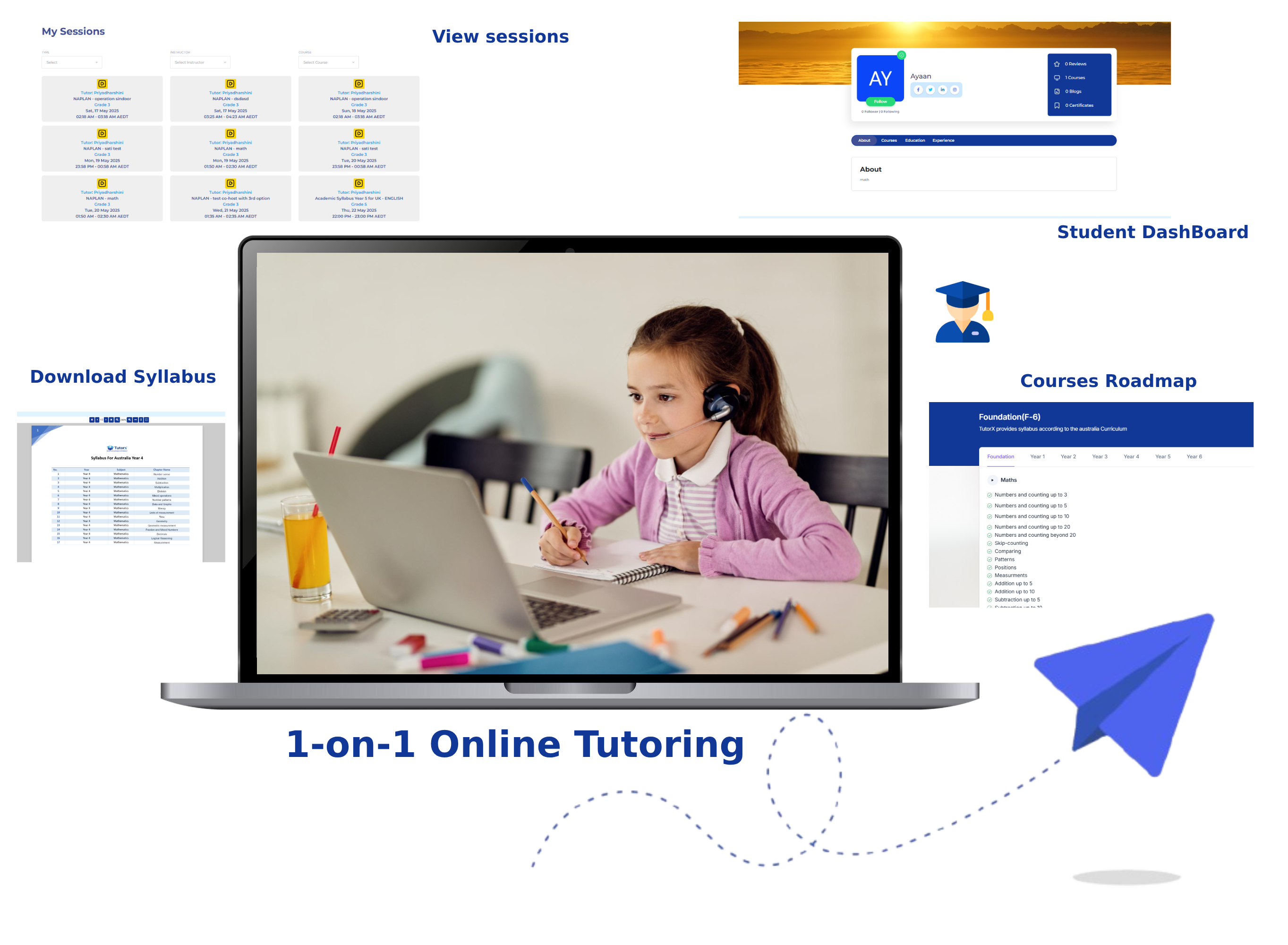Book a free trial session and start your personalized learning journey with our expert tutors.
Fill out the form below and one of our experts will contact you shortly.
Everything You Need, All in One Place
At The TutorX, we believe learning should be clear, focused, and at your fingertips. That’s why we’ve built a smart and user-friendly dashboard to empower every student on their academic journey. From live sessions and homework to performance tracking and resources—everything is seamlessly integrated to help you stay ahead with confidence.

The SAT (Scholastic Assessment Test) is a standardized test administered by the College Board. It evaluates a student's written, verbal, and mathematical skills through multiple-choice questions and a few student-produced responses. Originally a paper-based test, it has now transitioned to a Digital SAT, which is computer-adaptive and lasts 2 hours and 14 minutes, with a 10-minute break included. There is no negative marking for incorrect or unattempted answers.

The SAT is primarily taken by high school students who plan to pursue undergraduate studies. It helps demonstrate their college readiness and is often a requirement or a strong supplement for college admissions. Students aiming to apply to international universities that consider SAT scores as part of their admission criteria should take this exam.
The SAT is widely accepted in countries such as the United States, Canada, United Kingdom, and several others across Europe, Asia, and Australia. It is especially relevant for students applying to top global universities that recognize SAT scores as part of their undergraduate application process.
| Parameter | Reading & Writing Section | Math Section |
|---|---|---|
| Format | Two-staged: Separate Reading and Writing modules, each timed individually | Two-staged: Two separately timed math modules |
| Test Length (Operational + Pretest Questions) |
1st Module: 25 operational + 2 pretest 2nd Module: 25 operational + 2 pretest |
1st Module: 20 operational + 2 pretest 2nd Module: 20 operational + 2 pretest |
| Time Duration | 1st Module: 32 min 2nd Module: 32 min |
1st Module: 35 min 2nd Module: 35 min |
| Total Questions | 54 | 44 |
| Total Time Allocated | 64 minutes | 70 minutes |
| Scores Reported | Total score = Reading & Writing + Math scores | |
| Question Types | Discrete, MCQs with four options | MCQs (75%) + Student-Produced Responses (SPR) (25%) |
| Topics Tested | Literature, History/Social Studies, Humanities, Science | Algebra, Problem Solving & Data Analysis, Advanced Math, Geometry & Trigonometry |
| Informational Graphics | Included – tables, bar graphs, line graphs | Included |

The SAT Exam Syllabus 2025 includes subjects students commonly study in school: Reading & Writing and Mathematics. Previously, the SAT had separate sections for Reading and Writing, but in the digital version, they are now combined into a single Reading & Writing section. Although Science is not directly tested as a subject, it is included indirectly through passages in the Reading & Writing section that cover science-related content. There is no separate science syllabus in the SAT exam. The questions are designed to evaluate skills in comprehension, grammar, vocabulary, algebra, and problem-solving using real-world scenarios.
| Skill / Knowledge Testing Areas | Description | Weightage | Questions |
|---|---|---|---|
| Craft and Structure | Words in Context, Text Structure and Purpose, Cross-Text Connections | 28% | 13-15 |
| Information and Ideas | Central Ideas and Details, Command of Evidence (Textual and Quantitative Inferences) | 26% | 12-14 |
| Standard English Conventions | Boundaries, Form, Structure, and Sense | 26% | 11-15 |
| Expression of Ideas | Rhetorical Synthesis, Transitions | 20% | 8-12 |
| Skill / Knowledge Testing Areas | Description | Weightage | Questions |
|---|---|---|---|
| Algebra | Linear equations and inequalities, functions, systems of linear equations | 35% | 13-15 |
| Advanced Math | Nonlinear equations and functions, equivalent expressions, systems of equations | 35% | 13-15 |
| Problem Solving & Data Analysis | Ratios, percentages, distributions, probability, statistical reasoning | 15% | 5-7 |
| Geometry and Trigonometry | Area, volume, lines, angles, triangles, trigonometry, circles | 15% | 5-7 |
Administrator

Lorem Ipsum is simply dummy text of the printing and typesetting industry. Lorem Ipsum has been the industry's standard dummy text ever since the 1500s, when an unknown printer took a galley of type and scrambled it to make a type specimen book.
Lorem Ipsum is simply dummy text of the printing and typesetting industry. Lorem Ipsum has been the industry's standard dummy text ever since the 1500s, when an unknown printer took a galley of type and scrambled it to make a type specimen book. It has survived not only five centuries, but also the leap into electronic typesetting, remaining essentially unchanged. It was popularised in the 1960s with the release of Letraset sheets containing Lorem Ipsum passages, and more recently with desktop publishing software like Aldus PageMaker including versions of Lorem Ipsum.
Reach out to TutorX your questions spark the path to smarter learning
